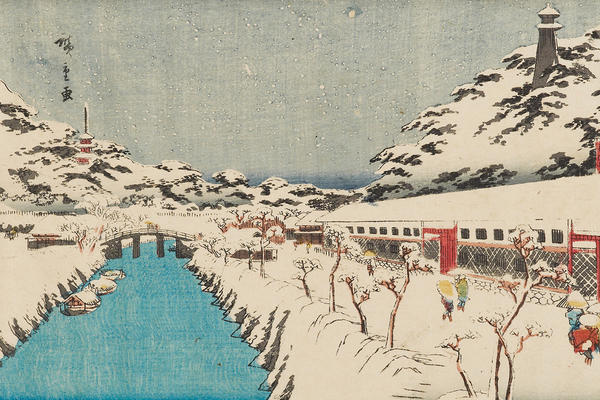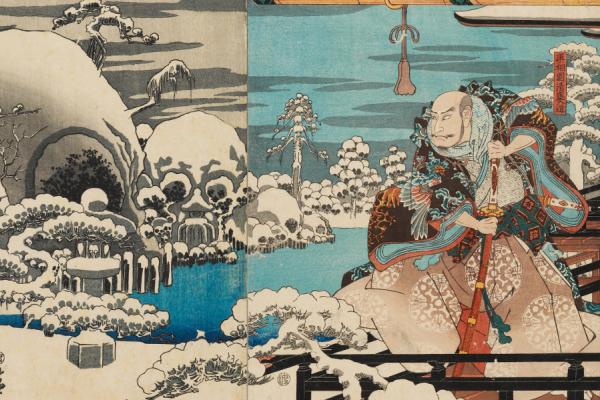WINTER ARTWORKS
4-minute read
We're celebrating the changing season by highlighting some of our favourite winter-inspired scenes and objects from the collections.
SNOWY JAPANESE PRINTS & PAINTINGS
Enjoy this selection of snowy Japanese prints and winter scenes to light up the season.
Snow in the Park (detail) by Toyohara Chikanobu
Sparrow in the snow (detail) by Utagawa Hiroshige
Boys building snowman by Morikawa Sobun
Snow at Mount Haruna in Kōzuke Province (detail) by Utagawa Hiroshige
Snow by Morimura Ray
The Tamaya Restaurant and the back gate of the Kameidō Shrine (detail) by Utagawa Hiroshige
Snow at Akabane in Shiba by Utagawe Hiroshige
Winter in Taguchi by Yoshida Hiroshi
Haunted by Spectres by Utagawa Hiroshige
Puppies in snow (detail) after Watanabe Seitei
Fujikawa by Utagawa Hiroshige
Gentoku visiting Komei in his retreat, in a snowstorm (detail) by Tsukioka Yoshitoshi
Black bear cub in snow by Mori Shuho
Mishima by Utagawa Hiroshige
MORE WINTER SCENES
Winter Landscape with Skaters by Aert van der Neer, c. 1665

Aert van der Neer was a Dutch artist who specialised in moonlight scenes and winter landscapes.
In this oil painting, he managed to capture the subtle effects of light and colour in the wintry climate. A large number of people have gathered on the frozen river for entertainment. Some are ice skating or playing a game of 'kolf' (medieval golf), while others are enjoying a leisurely stroll with family members and pet dogs. Although a windmill can be seen on the right of the landscape, this scene is probably imaginary and does not depict a particular location.
On display in the Dutch & Flemish Art Gallery 45, level 2
LI074.1
Ice skater coin, 18th century

This late 18th century coin featuring an ice skater on the reverse is a private ½ penny token, struck by Gamaliel Skidmore (c.1775–1822).
Gamaliel Skidmore's family owned a stove and grate business in Birmingham, but he was born and brought up in London. The family were 'enterprising', moving to New York for a while and trying to find their luck there through all sorts of wheeling-dealing. His father John Skidmore was known as a ‘reprehensible dealer’, so not much to write home about!
Private tokens like this were used in Britain at the time because the Royal Mint had stopped producing small change. They were very popular and often were also produced for the collectors’ market.
Not currently on display
HCR7361
Frost by William Bell Scott, 1826–1890
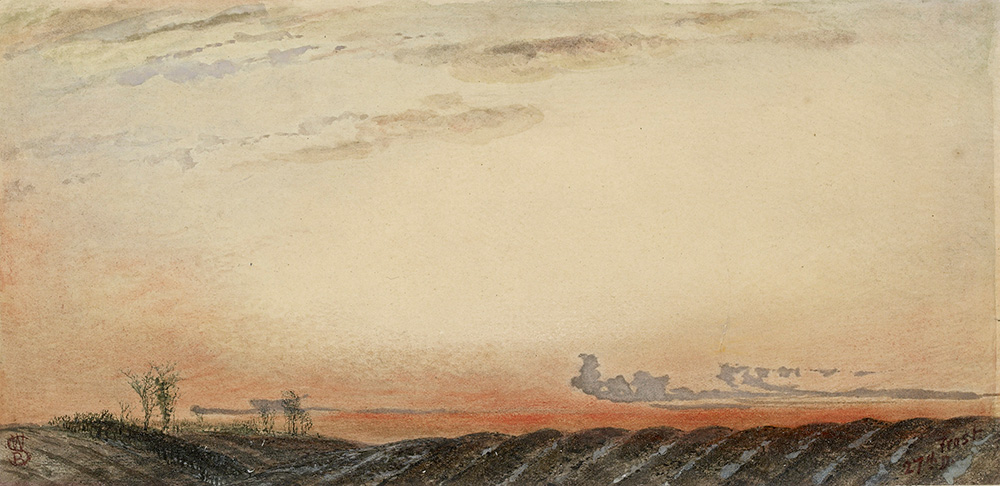
This sparse, but atmospheric painting of a frosty furrowed field under a sun-tinged sky is by the Scottish artist William Bell Scott (1811–1890). Although he does not give a year for this work, it is dated '27th D[ecember]', so we know it was done in the depths of winter.
There is a companion subject to this work called 'Snow', in which a man trudges head-down against the wind through a swirling snowstorm. You can view both of these watercolours in the Western Art Print Room.
Scott was also a poet and illustrator, and his posthumously published autobiography vividly evokes life in the Pre-Raphaelite circle. He was especially close to Dante Gabriel Rossetti and the poet Algernon Charles Swinburne (1837–1909). A line from Swinburne's 'Ode to March' – remembering the past winter – seems appropriate to this view of the icy fields: 'One hour of the sun's when the warm wind wakes him to wither the snow-flowers that froze as they bloomed'.
Viewable by appointment in the Western Art Print Room
WA1973.154
The Dryad's Waywardness: Oak Spray in Winter, seen in Front by John Ruskin, 1858–1860
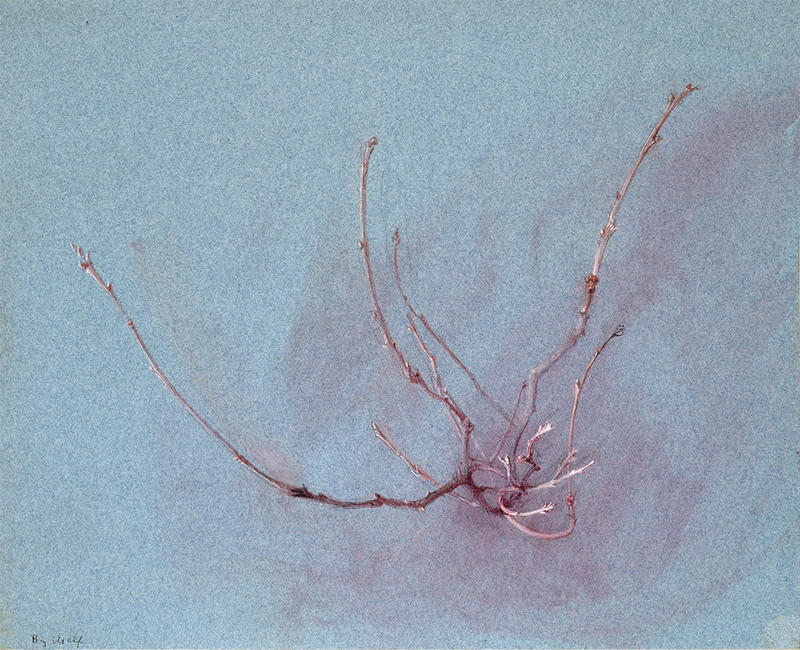
In watercolour and bodycolour over graphite on blue wove paper, this finely executed drawing by John Ruskin brings to life the delicate, twisting shapes of the oak branch in its simple winter's state, bare of leaves.
The unusually poetic title of the image was given when it was engraved for the last volume of Ruskin's great work on art, Modern Painters, published in June 1860. It refers to the sometimes unruly habit of the oak tree, and especially the complex curvature of the boughs. Ruskin emphasised that branches were generally best viewed from the front, in foreshortening, as in the case of boats.
A second drawing of the same branch seen in profile is entitled The Dryad's Toil (WA.RS.ED.265). Dryads, often imagined as female tree nymphs in Western mythology, were originally the spirits of oak trees – from the Greek word 'drys', meaning tree.
Viewable by appointment in the Western Art Print Room
WA.RS.ED.266 & WA.RS.ED.265
Winter scene by Gustave Courbet, 1865–1873

From 1865 until his death, Courbet painted many landscapes under snow, inspired by the countryside of his native Franche-Comte.
This atmospheric view is smaller and more refined than many, and perhaps dates from the beginning of this period.
Gustave Courbet was the leader of the Realist art movement, who rebelled against the Romantic painting of his day by choosing to depict everyday scenes and day-to-day life in his artworks.
On display in the 19th-Century Art Gallery (Gallery 67)
WA1936.48
Winter landscape by Guiseppe de Nittis, c. 1870

The Italian-born painter De Nittis became closely associated with the Impressionists through his friendship with Degas, exhibiting at the First Impressionist Exhibition in 1874. In this rapidly sketched snow scene, swiftly brushed in with a minimum of colours, a woman appears to be sweeping the garden path of a suburban villa. It could be one that belonged to De Nittis himself at St-Germain-en-Laye on the western outskirts of Paris. The road between the villas and the railway bridge to the left add a note of modernity to the location.
After studying in Naples, de Nittis moved to Paris in 1868 and became a close associate of Degas and the Impressionists. He frequently made atmospheric studies on small wooden panels outdoors in the new suburbs of Paris.
On display in the Landscapes & Nature Oil Sketches Gallery (Gallery 51)
Courtesy of The Gere Collection, normally on long-term loan from the National Gallery
Farm at Montfoucault in snow by Camille Pissarro, 1874–1876
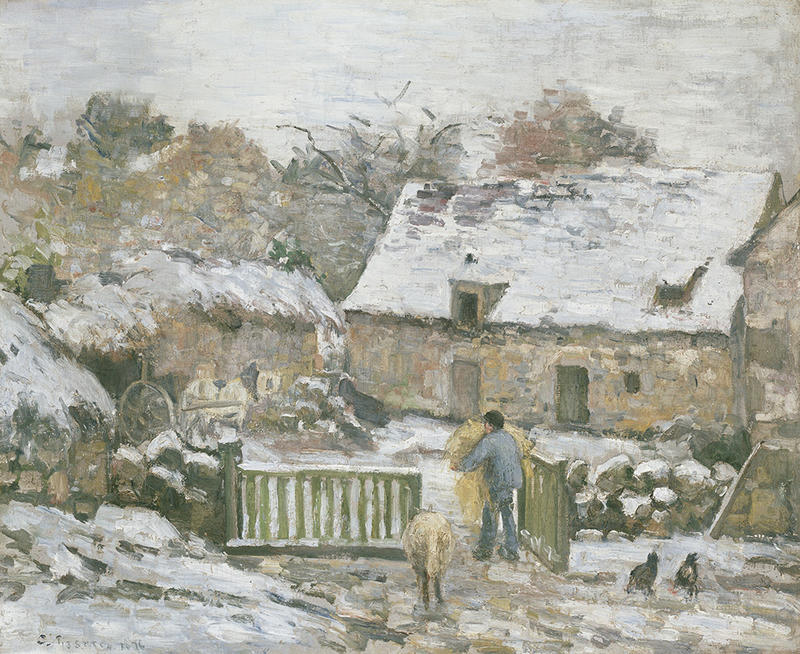
Montfoucault was one of the farms owned by the Piette family in Mayenne, where Pissarro spent long periods between 1874 and 1876. The landscape here was different from that of Pontoise (where Pissarro lived on and off from 1866 to 1882), made up of small fields enclosed by hedgerows, with the horizons blocked.
Pissarro's style became more rustic, in keeping with the landscape. He used shorter brushstrokes in thicker paint, particularly effective for the snowy scene, creating a more rugged surface and expressive texture.
On display in the Pissarro Gallery (Gallery 65)
WA1951.225.2
Snow on Groves by Wu Hufan, 1938
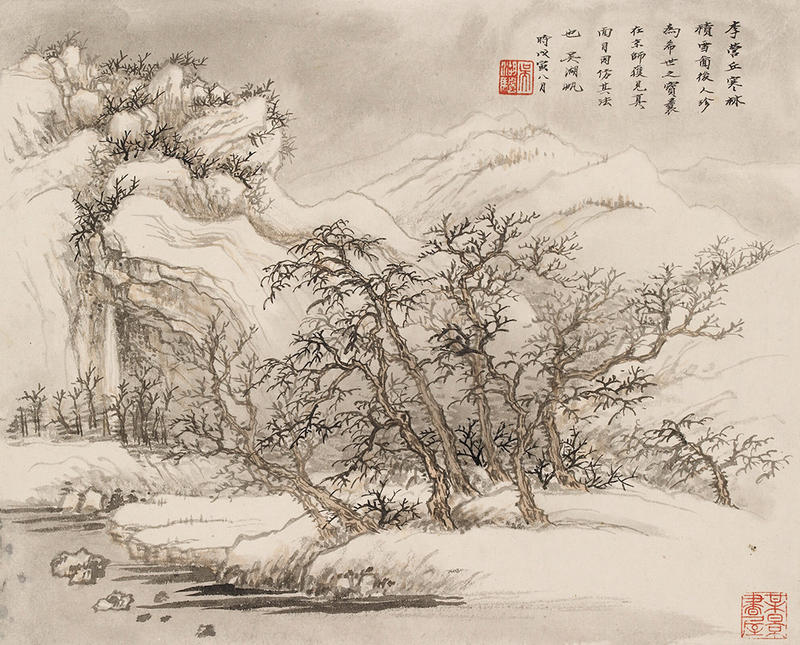
The Chinese artist Wu Hufan produced this evocative snowy painting in inks and slight colour on paper, mounted on card, and framed with juan silk and brown paper.
Wu Hufan was born in Suzhou, Jiangsu province. He was a revered Chinese landscape painter, and was also known for his collection of traditional paintings and his connoisseurship. As the grandson of Qing period painter and calligrapher Wu Dacheng (1835–1902), Wu Hufan was able to access and study many original masterpieces. He is especially known for his study of the ‘Four Wangs’ from the Qing dynasty (1644–1911), Dong Qichang (1555–1636) of the Ming dynasty, and also Dong Yuan, Juran (active AD 660–995) and other Song dynasty (AD 960–1279) master painters.
Not currently on display
EA1995.254
Winter by Orovida Camille Pissarro, 1940

This artwork was likely to have been conceived for the first set of 'Seasons' paintings by the artist Orovida Pissarro, and was included as 'Winter a skating scene' (private collection). It was not completed until 1940.
Orovida was a printmaker and painter, who worked often on linen and silk. Born at Epping, Essex to the artist Lucien Pissarro, she was the grand-daughter of Camille Pissarro. She studied with her father Lucien. In 1914 in France she started experimenting with etching, then on return to England 'bought a press and a book on the technique of etching and set to work'. A big exhibition of Chinese painting in 1914 left an indelible impression, and some of Orovida’s most memorable etchings are of Asian subjects, especially animals. She exhibited at the Royal Academy and had one-man shows in London and North America. In 1969 the Ashmolean held a memorial show of her etchings, paintings and drawings and published a catalogue of her etchings and aquatints.
Not currently on display
Image courtesy the artist's estate
WA1952.6.19
Winter Pond by Naoko Matsubara, 1971
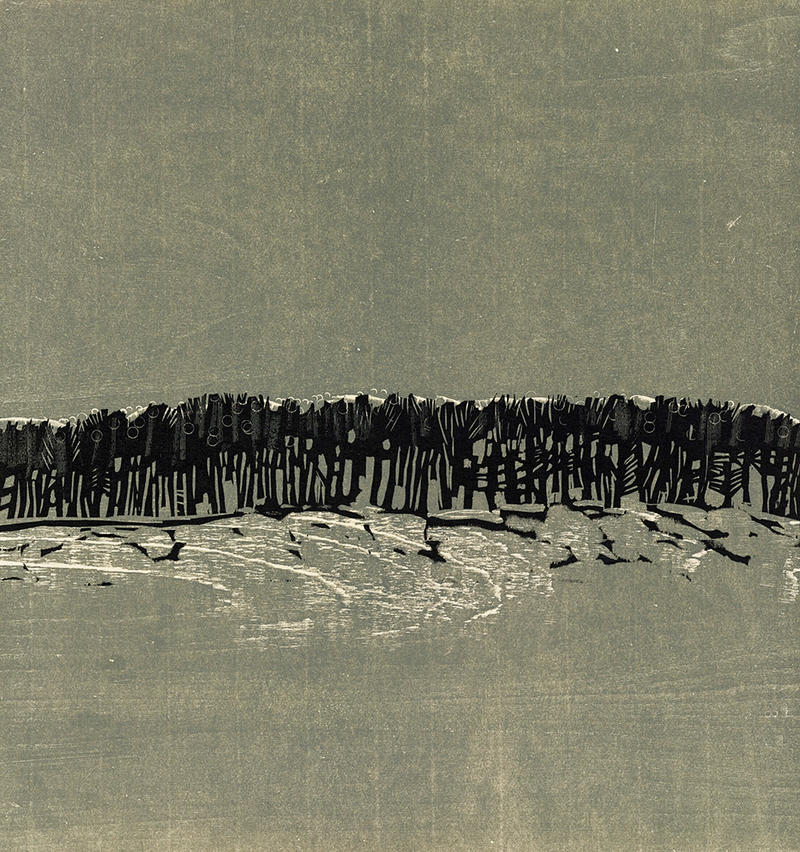
‘Every winter the liquid and trembling surface of the pond, which was so sensitive to every breath, and reflected every light and shadow becomes solid to the depth of a foot or a foot and a half….’ (Henry Thoreau).
This print is from a portfolio of 11 woodcuts created in response to the book Walden by the American writer Henry David Thoreau (1817–62). From 1845 Thoreau spent two years alone in a log cabin he built deep in the woods beside Walden Pond, near Concord, Massachusetts. The book he wrote during his stay emphasised the importance of living at one with nature.
Naoko Matsubara, who was based in New England when commissioned to work on this project, took her inspiration from the chapter entitled ‘Solitude’: ‘I found the book very similar in spirit and thought to Shinto, the religion and cultural frame of reference in which I grew up. Living near Walden Pond, I frequently went there during the course of one year’.
The designs show a sensitivity to the changing seasons, and express the sense of stillness and quiet reflection that run through Thoreau's essay.
Not currently on display
EA2018.166.13









